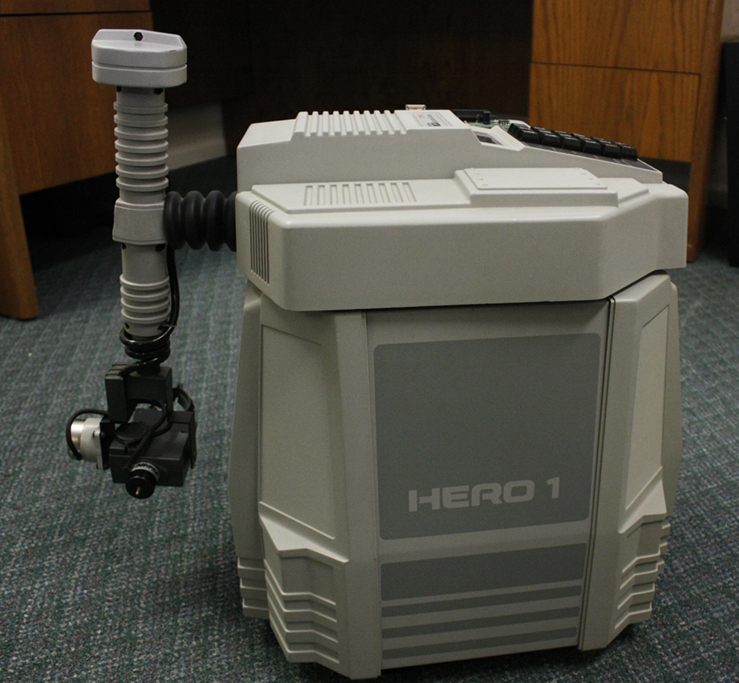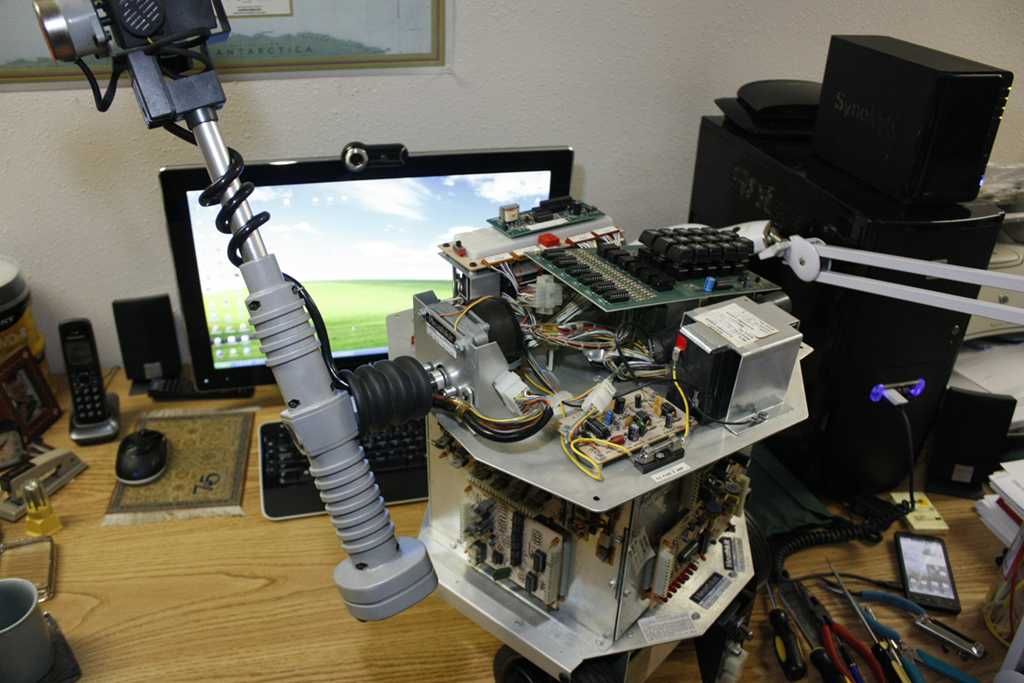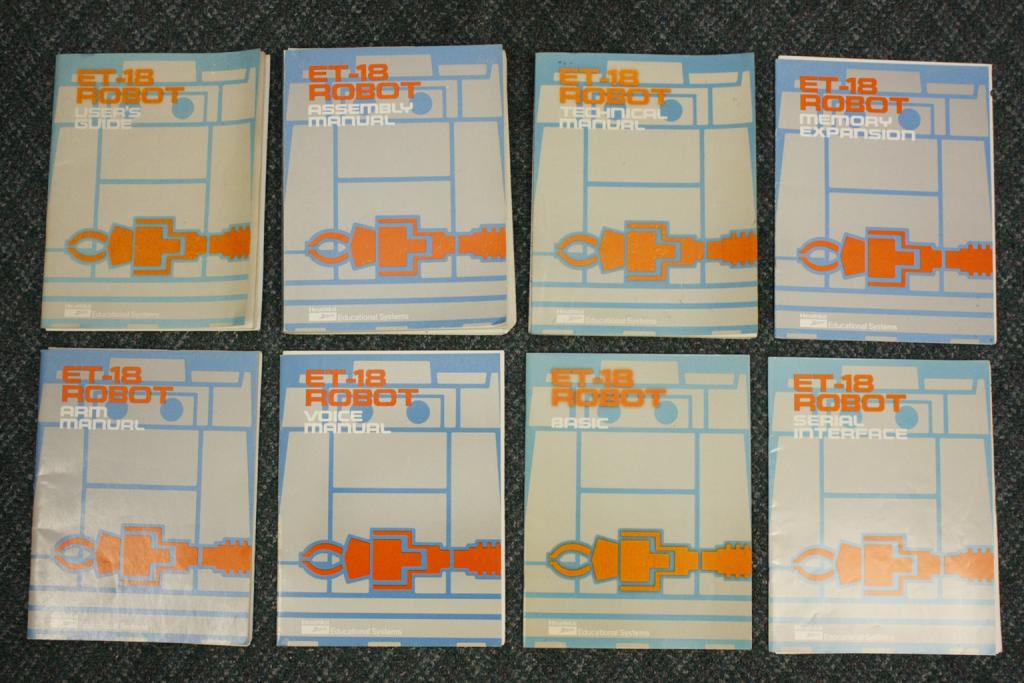HERO-1 Coming up for sale soon.
I'm a volunteer at the Siuslaw Public Library in Florence, OR (mid-way along the Oregon coast). A long-time resident of our town passed away last year and donated her rather extensive collection of early computer gear to the library. We've been cataloging it, cleaning and restoring hardware to operation, with the intention of placing it for sale on eBay. Among the collection is a Heathkit HERO-1 robot, in [now] good condition. With new batteries installed, it's fully functional and mobile, with battery charger, teaching pendent, working arm, voice, serial interface, 24K of RAM, UTILITY and BASIC ROMs, and all the original manuals, schematics, illustration booklets, and errata. There's even a cross-assembler for the robot meant to run on a Heathkit H-8 under CP/M (we have two working H-8 systems we'll be listing on eBay as well). Much of this will start being posted on eBay in the near future (a few weeks at most). I just wanted to make forum members aware of the coming opportunity. Our library depends on donations such as these to cover some of our operating costs; hence, we hope to make as much money as possible, but we're equally interested in fair pricing and providing an honest representation of all the things we'll be selling. We're also somewhat concerned about shipping the robot -- not the cost so much, but rather how to maximize the likelihood of it arriving at a buyer's door in the same condition it left ours. If any forum members have first-hand experience and advice on this topic, we would very much appreciate sharing it with us.





Comments
In the event anything gets broken I have spare parts for the HERO robots and can also do repairs on the boards.
Best Regards,
Robert
Thanks for the advice Robert. I'm torn between leaving the exterior panels in place or shipping them separately. I like the thought that they'd provide some protection but I also worry they could get damaged themselves from the robot jostling around normally in its box. I also assume it would be best if the robot remains upright during shipment.
Here's a thought: You might consider adding custom shipping materials for HERO's to your product line(s). Probably not a huge market, but I'd probably buy that product right now...
Doc
That is the question, isn't it? The person selling a Hero-1 would likely give a very different answer than a prospective buyer might. That's the virtue of eBay. The buyer community decides what it's worth. Which is not to say we're a disinterested seller. We may be a non-profit organization, but we would like to see our Hero-1 go for a reasonable price as it will help fund the community services of our library -- things like internet service for local students and residents. I'll get off my soapbox now. Assuming your question wasn't rhetorical: the most recent eBay HERO-1 sale I found was for $650 + $125 shipping in Oct. 2012.
Doc
We really appreciate your pricing information. The robot is in good shape. It's been cleaned, the I/O, CPU, and extended memory boards have been pulled, their IC's reseated and contacts cleaned, and questionable solder work touched up. Cable connectors have all been cleaned and reseated. The arm control board had some issues but they've been addressed. The arm's exo-skeleton interior shoulder mount had been badly damaged before we got it. Luckily, the arm casing can be flipped, so now the interior shoulder mount is good as new though there is some scarring visible now on the exterior shoulder mount -- hey, we've all got a few scars after 30 years. The exterior panels and top cover are in very good shape -- there's a couple of small scratches on one of the side panels and that's it.
The biggest problem was the low-density foam that Heathkit used around the sonar tubes, the battery compartments, and the arm gripper. The stuff had seriously decomposed; granules were everywhere inside, and the adhesive residue was a mess to clean up. There's now new foam in the battery compartments and I may put new foam around the sonar tubes, but I'm intending to leave the gripper bare for the new owner to address, depending on their application. Everybody from that era used cheap single- or double-sided foam. The worst offender was probably Atari. It's been the bane of my restoration work.
I have replacement foam pad sets for the HERO 1 gripper. There are two different styles. Either black or orange (to complement the body panels). A while back I had some reproduction foam pads for the sonar. I've been out for a while but do plan on getting some more made up.
Robert
Thanks in advance
I also bought the educational course separately (included in the OP's description here). That material may not be "state of the art", but it has relevance with the HERO bot, so it's a value-added bonus.
Is that a Gemini you're leaning on in your avatar pic, Gordon? Still got it? I bet your house/shop/garage are even more interesting than mine.
It's a Gemini, which as you know is pretty rare. But it's not mine. It belongs to my friend John Boisvert, who like Robert is a HERO (and other robot) collector. John bought out the inventory for the RB5X, and for a while was selling complete and partial new robots.
Interestingly enough, I'm not a collector. It's not something I do. I research, buy, enjoy, then set it back out into the wild. So I'm afraid my house/shop/garage is actually pretty boring.
Mark Robillard wrote up some of these in this R-E article back in '86:
https://archive.org/stream/radio_electronics_1986-03/Radio_Electronics_March_1986#page/n37/mode/2up
And of course Robert's own well-researched pages:
http://www.robotworkshop.com/robotweb/?page_id=146
Disappointed! I'll bet they are neat and tidy too.
Never.
The original boards contain chips that are obselete; which implies; that if a chip goes bad, you may have to
kiss HERO goodbye. I am trying to get the original program off of the control board, in order to be able to
program my beaglebone with the same personality. I would then put the beaglebone in place of the controller,
and HERO Jr. will live on.
I would think the toughest part is programming the I/O. There are some sites that have some details:
http://hero.dsavage.net/robots/Hero_FAQ.html
but I don't know how complete they are. Some pieces, like the speech synthesizer phonemes, could get pretty hairy For something like this you might have to dig really deep. Fortunately, Radio Shack's old speech synthesizer hardware used the same chip, and they were known to provide some fairly decent technical details. (I'm not talking about the surplus SP0256 chips they sold, but the hardware box that was provided as an add-on to the TRS-80.)
Something like this...
https://archive.org/details/VS100_Voice_Synthesizer_Manual_19xx_Alpha_Products
So, nevermind.
If the HERO Jr ever gives you any trouble let me know. I have all of the parts on hand to repair and rebuild these. You can get the parts you need to fix it yourself or if you prefer I have test fixtures setup here for working on all the HERO boards so just the boards can be sent in for repairs.
Typically the HERO Jr tends to be a very reliable robot once they have been gone through. I even have the latest V1.6 Main ROM set that I patched with a Y2K fix so the robot can say the correct date. The main 5V supply typically runs a bit high closer to 5.5V but there is a fix for that as well by replacing a resistor on the power sense board.
Robert
It is possible to use a SpeakJet to do a reasonable emulation of an SC-01 speech chip. Back in 2007 I wrote an article for SERVO on that project. It used a Parallax SX28 processor to handle all the translation. Since it was an early article SERVO gave me permission to post it online on my website:
http://www.robotworkshop.com/robotweb/wp-content/uploads/servo200712_HERO_Speech_translator.pdf
It shows what can be done if any of the special chips like the SC-01 completely run out. Luckily they can still be found. I rarely see those chips go bad. The only two I have had to replace were on HERO Jr's. One was due to someone connecting the 12V battery backwards and the other was caused by someone who tried two 12V batteries in series (24V total) instead of two 6V batteries in series (12V total). If someone makes a mistake like that then you can smoke that SC-01 chip. There have only been those couple instances so it is pretty rare and usually a user issue that causes it.
The HERO Jr uses a Motorola 6808 CPU.
Robert
http://www.ebay.com/sch/i.html?_from=R40&_sacat=0&_nkw=Hero JR Robot&LH_Complete=1&rt=nc&_trksid=p2045573.m1684
As it says in the opening post "..donated her rather extensive collection of early computer gear to the library..". Was her idea that all that stuff ends up in private hands. Flogged off on ebay?
As a practical matter if the odd 300 bucks raised by such a sale is a desperate attempt to raise money the whole operation is doomed anyway.
What am I missing here?
It's a new poster, and he/she should have started a new thread.